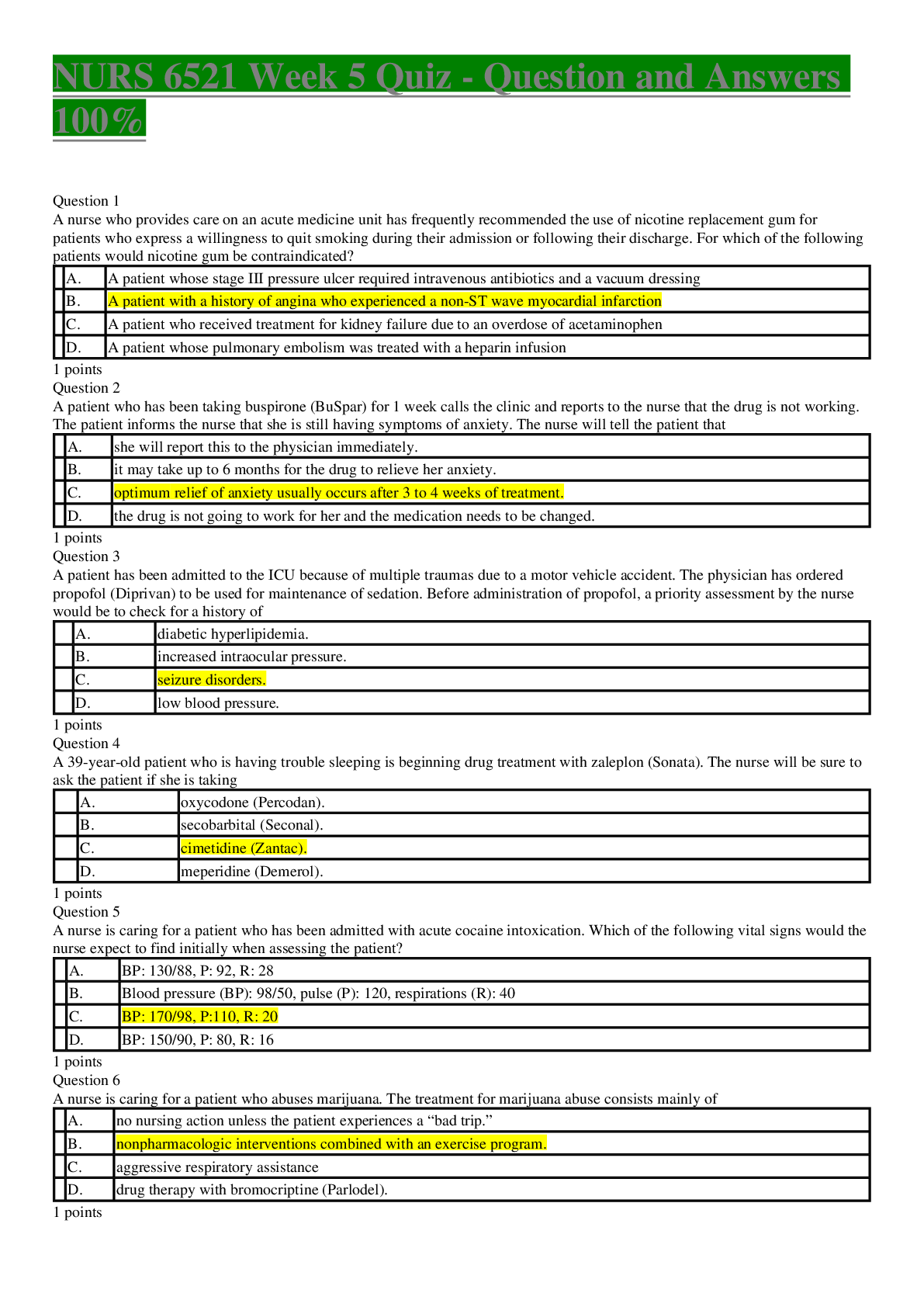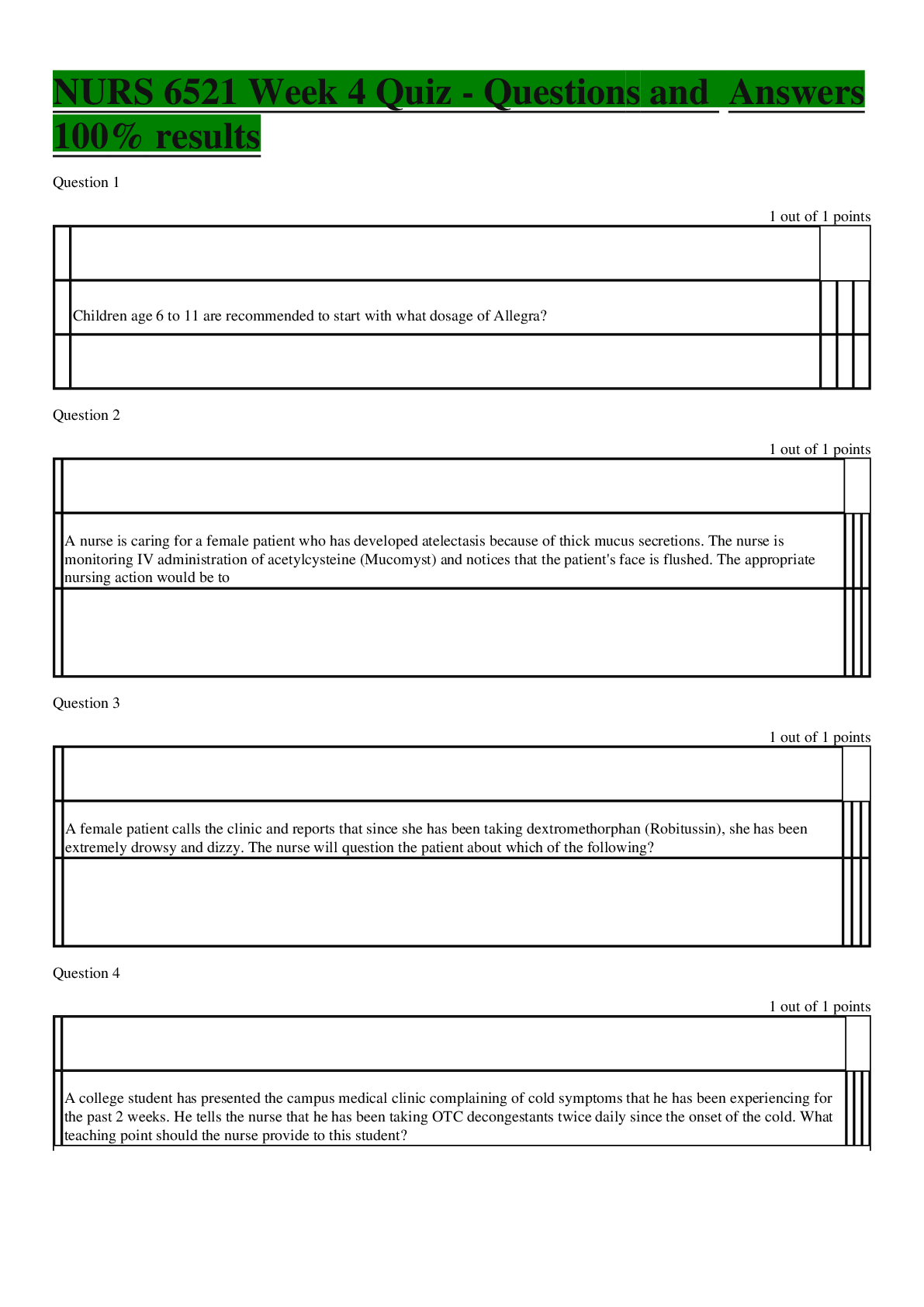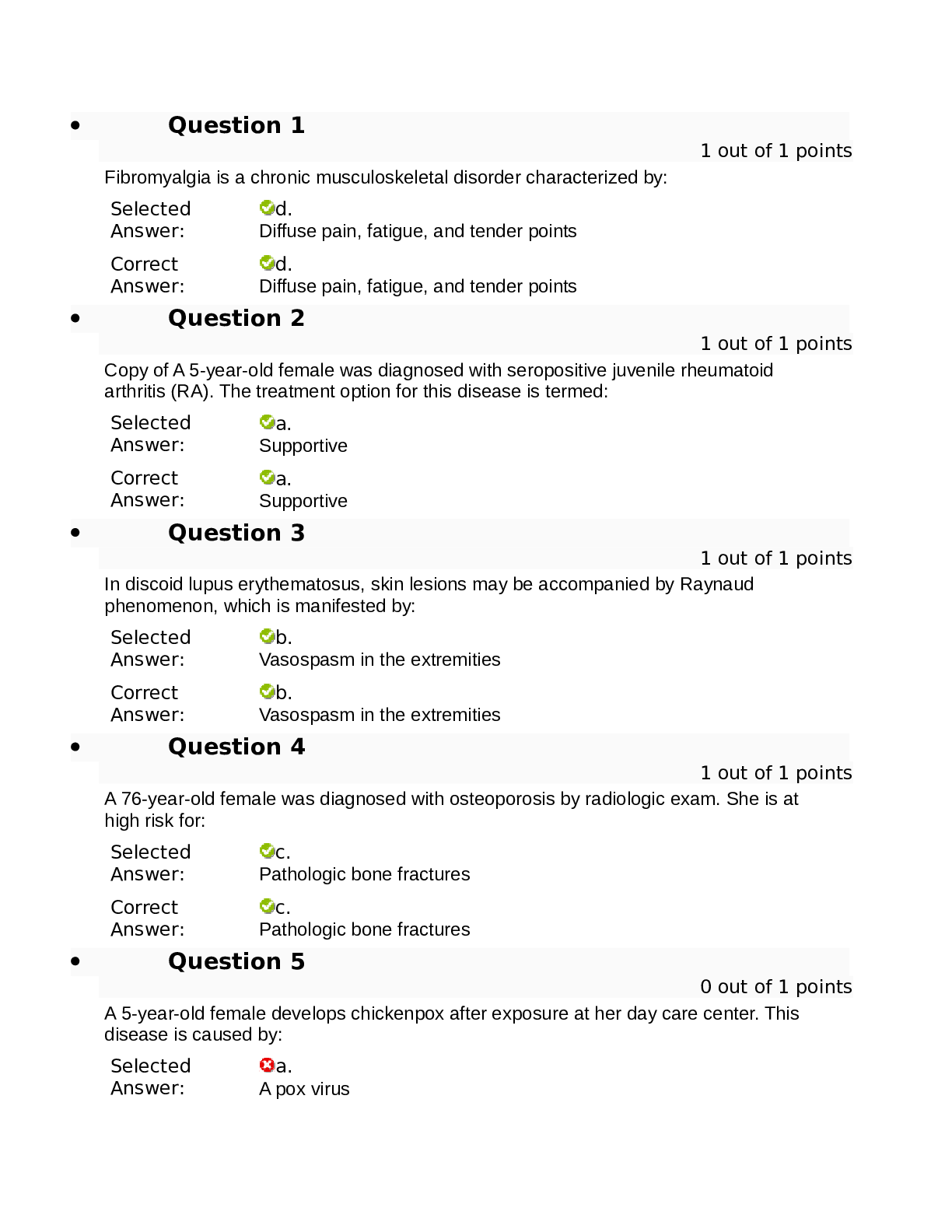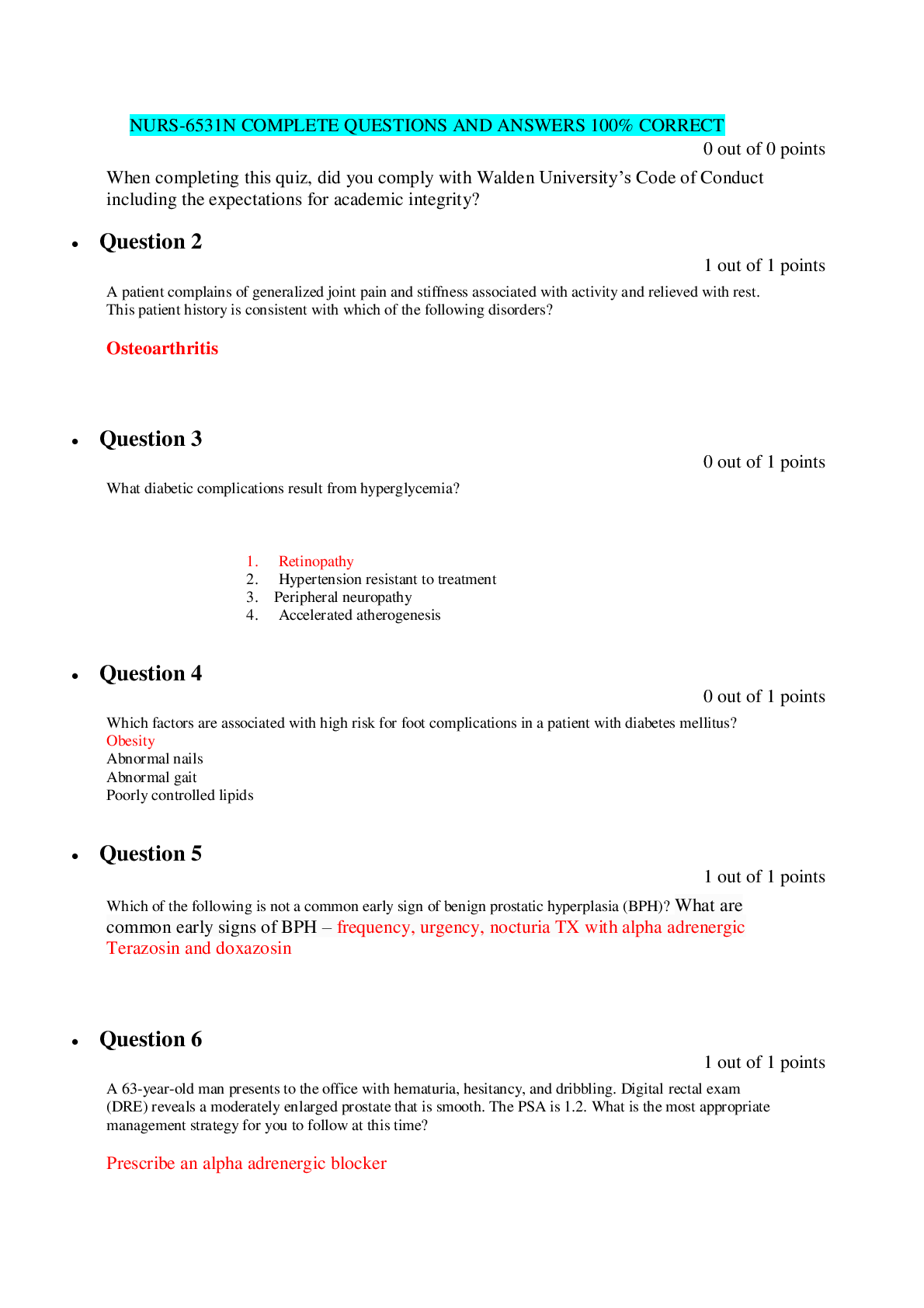Health Care > QUESTIONS & ANSWERS > Crossfit Ultimate Level 2 Questions and Answers 100% Pass (All)
Crossfit Ultimate Level 2 Questions and Answers 100% Pass
Document Content and Description Below
Crossfit Ultimate Level 2 Questions and Answers 100% Pass the subjects in the cross-fit study were on which diet? Paleolithic what journal was this article published in? Journal of Strength and C... onditioning Research Publish Ahead of Print high intensity power training (HIPT) -new variation of HIIT -incorporates high intensity resistance training using varied, multiple joint movements -also offers improvement of aerobic fitness with minimal time commitment compared to traditional aerobic training -many unsubstantiated claims how does HIPT differ from traditional HIIT? -includes a lack of prescribed rest period -focuses on sustained high power output -uses multiple joint movements HIPT training session often includes a random selection of multiple joint exercises and train participants to complete these movements at high resistance as quickly as possible can HIPT offer the same benefits as HIIT like improved body composition and VO2 max in healthy adults? not clear hypothesis -10 week HIPT regimen would improve VO2 max and body composition in healthy adults -improvements of VO2 max and body composition would be found across all levels of initial aerobic fitness and body composition body composition measurement methods using air displacement plethysmography (Bod Pod) and maximal aerobic capacity using treadmill graded exercise test air displacement plethysmography using air or water displacement to determine body volume -in exercise science it usually refers to underwater weighing or the "Bod Pod" for assessing body composition subjects 43 (23 males and 20 females) -began with 54 -Paleolithic diet -participants of all levels of aerobic fitness and body composition -trained at a Crossfit affiliate dependent variables body composition and VO2 max paleolithic paleo: ancient litho: stone paleolithic: stone age paleolithic diet "caveman diet" -modern nutritional plan based on the presumed ancient diet of wild plants and animals that various hominid species habitually consumed during the Paleolithic era -centered on commonly available modern foods -consists mainly of fish, grass-fed pasture raised meats, eggs, vegetables, fruit, fungi, roots, and nuts -excludes grains, legumes, dairy products, potatoes, refined salt, refined sugar, and processed oils Paleolithic era period of about 2.5 million years which ended around 10,000 years ago with the development of agriculture methods training program: -crossfit based HIPT program using basic gymnastic skills (handstands, ring, and bar exercises) and traditional multiple joint, functional, resistance exercises (squat, press, deadlift, Olympic lifts) -performed as quickly as possible at high intensity -supervised by FACSM and physiologist graded exercise testing: -performed maximal treadmill exercise test before and after training program using Bruce protocol to determine VO2 max Olympic lifts -snatch -clean and jerk Bruce protocol most commonly used treadmill protocol was initial level of aerobic fitness a predictor of improvement? all levels increased results all positively changed discussion -results confirm hypothesis that 10wk crossfit HIPT significantly improves maximal aerobic capacity and body composition in individuals of all fitness levels and genders -indiciate positive role of HIPT in reducing body fat & in both genders across all levels of initial fitness -impossible to ascribe the entirety of improvement bc of diet was this the first investigation showing that similar benefits of HIIT can be obtained using HIPT? yes what was the major concern mentioned by the authors regarding this type of training? risk of overuse injury was there a notable percentage of the subjects that did not complete the training program and return for follow up testing? yes 16% risk-benefit ratio for extreme training reports of increased rates of musculoskeletal and metabolic injury in these programs advice to future studies explore hoe to best realize improvements to health without increasing risk above background levels conclusion this program can yield meaningful improvements of maximal aerobic capacity and body composition in men and women of all levels of fitness cross fit study regarding injury risk purpose: -determine the injury rates and profiles of crossfit athletes sustained during routine crossfit training subjects: -online questionnaire distributed amongst international crossfit online forums conclusion: -injury rate of 3.1 per 1000 hours trained calculated -injury rates with crossfit are similar to those reported for sports (ex. Olympic weight lifting, power lifting, and gymnastics) but lower than competitive contact sports (ex. rugby) -1st paper detailing injury rates and profiles with crossfit participation injury rates from cross fit training appear to be lower than in rugby true The skeleton protects organs and allows our muscles to create movement How many bones are in the body? 206 Periosteum A soft, yet tough outer membrane over the bone's entire surface Compact Bone (cortical bone) The hard, rigid layer that gives the bone it's shape and structure. Cancellous (spongy) bone The soft inner layer that provides the elastic strength of the bone Bone marrow The soft innermost layer that is responsible for the production of red blood cells and platelets, which are important for blood clotting Long bones Defined as having a body that is longer than it is wide -primarily found in the extremeties and are the bones which create major levers in human movements Short bones Defined as being as wide as they are long -They have a greater role in support and stability as opposed to movement Irregular bones Those that do not fit into any other category -Their odd shape provides multiple points of attachment for muscles, tendons and ligaments Flat bones Relatively thin, flat plates of bone that protect vital organs ex.(skull, ribs, pelvis) -Flat bones serve as the primary production site for eukaryocytes (red blood cells) Sesamoid bones Short or irregular bones that are embedded with a tendon ex.(patella) -they serve to protect tendons and act as pulleys that improve the efficiency of a muscles pull Tuberosities, tubercles and processes Bony protuberances ranging from large to small that serve as attachment sites for tendons Spine A long, thin projection that serves as a muscular attachment site Condyle The cartilage covered, round end of a bone that forms a joint surface Epicondyle A bony outcropping that is found near the condyles -serves as a muscle origin and insertion points Fossa A concave or bowl-shaped depression in which another anatomical structure sits Foramen An opening in a bone through which nerves, veins, arteries and muscles can pass Notch or groove A depression in a bone that serves as a pathway for tendons, nerves, arteries and veins Joints The connection between two or more bones Synovial joints Mobile joints involved in human movement Hinge joints articulations (joints) that allow motion in only one anatomical plane ex.(elbow) -only movements are flexion and extension Pivot joints Joints that allow rotation as only movement ex.(neck between the atlas and axis) Ball & Socket joints Most mobile joints and allow different motions ex.(hip and shoulder) Gliding joints Allow for a limited amount of motion in only one plane Saddle + condyloid joints Involves a concave surface of one bone sliding over the convex surface of another bone Joint capsule Encloses the synovial joint and is attached to the periosteum of bones that comprise the joint Outer layer (of the joint capsule) Dense and fibrous, has many nerve endings but poor blood supply Inner layer (of the joint capsule) Rich blood supply but poorly innerviated -The blood vessels within the inner layer act as an entry of nutrients for the joint and an exit for waste Synovial membrane Next tissue found beyond the inner layer of the joint capsule -the function is to produce + secrete synovial fluid Hyaline cartilage Smooth, white covering of all synovial joint surfaces -function is to decrease friction within the joint and act as a sliding surface for the 2 bones Smooth muscle Found within walls of organs -involuntary Cardiac muscle Found only in the heart -involuntary Skeletal muscle Responsible for human movement -voluntary, striated Fascicle A bundle of muscle fibers Muscle fibers Muscle cell. Long and cylindrical, contains the proteins actin and myosin, which are responsible for muscle contraction Myofilaments Arrangements of actin and myosin Tendons Connective tissue connecting muscle to bone Ligaments Fibrous connection of bone to bone Origin and Insertion The two attachment points of the muscle Origin Fixed location of the body segment Insertion Moving body segment Sprain Tearing of a ligament or joint capsule -often occur when a joint is forced beyond its natural range of motion Strain Stretching or tearing of a muscle or tendinous structure Aponeuroses flat sheet like tendon attachments Concentric Contraction Occur when the tension in the muscle is great enough to overcome the load of the muscle. The muscle will shorten in length under tension. Eccentric Contraction Occurs when tension is maintained in a muscle and the length of the muscle increases Isometric Contraction Refers to muscle contractions where the tension in the muscle neither overcomes nor yields to the load on the muscle. the muscle will neither shorten nor lengthen Rhabdomylosis When the breakdown of muscle tissue is too great for the body to handle, in extreme situations the contents of muscle cells, such as myoglobin can overwhelm the kidneys and lead to renal failure or even death Central Nervous system Consists of the brain and spinal cords Peripheral nervous system Composed of the nerves extending off the spinal cord Neurons Nerve cells Foundations of Effective Training Teaching seeing correcting group management presence and attitude demonstration Teaching Effectively articulate and instruct the mechanics of each movement, focus on major points of performance before more subtle and nuanced ones, change instruction based on the athletes needs and capacity and teach athletes how to improve poor positions and movement patterns. Knowledge in fitness related areas Ability to accurately convey as much knowledge as possible to others. Effective Communication Be able to change communication style to meet the capacity of the student and change strategies until the athlete succeeds. Assess the effectiveness of teaching and communication Determining whether an athlete meets performance expectations. Teaching as much as neccessary Reduce and simplify body of knowledge to one or two most critical points. Seeing Ability to discern good from poor movement mechanics and identify both gross and subtle faults with athletes in motion and static. Static Faults When the athlete is not moving, even briefly. In the starting, receiving and finishing positions. Dynamic Faults When the athlete is moving between static positions. Most useful dynamic view A profile view offset by 45 degrees Difficulty seeing dynamic faults increases when Athlete moves quickly and faults become subtler Methods to develop ability to see faults Study film Survey athletes for only one fault at a time Correcting Ability to facilitate better mechanics for an athlete using visual, verbal or tactile cues. Ability to triage faults. Understanding of how multiple faults are related. Correcting mechanics results in Increased performance gains and decreased risk of injury. Abilities for correcting Use successful cues Know multiple corrections for each fault Triage faulty movement Balance critique with praise. Cues Direction to help an athlete execute perfect mechanics. Good Cue Any cue that results in improved movement mechanics Cues do not Perfectly describe the mechanics of the movement Cues should be Short Specific Actionable Actionable cue Gives a single task for the athlete to complete Fault Identification - Bad Cue Pointing out the fault, does not tell the athlete how to fix it Cue language Simple and easily understood by anyone Three step cue proccess Identify the fault Identify what is out of place Give direction to that body part If athletes movement does not improve Use multiple cues until the fault is resolved Corrective strategies Verbal Visual Tactile Verbal Cues Tell an athlete a specific instruction Visual Cues Create contrasting images between current and desired positioning Tactile Cues Use physical targets to achieve proper mechanics Triaging faults Assigning urgency to the multiple faults present in order of most to least important Order for triaging Highest risk for injury first then severity of deviation from ideal After delivering a cue Stay with athlete for at least another rep to assess result Cue feedback Let the athlete know if movement was same, better or worse If cue is unsuccessful Find a new cue, do not repeat unsuccessful cues with the same athlete Praise Reserved for actual improvement, not as a fille Praise for hard work Be clear when praise is for effort rather than a movement that still needs improvement Group Management Ability to organize and manage. Includes managing time well, organization of the space, equipment and participants for optimal flow. Poor planing Can detract from the quality of the class experience Optimum management Results in the best possible instruction Adhere to the schedule Start and end on time Ending late occurs when A trainer doe snot plan ahead and think through the entire class schedule Following a simple schedule template Ensures necessary time is devoted to each piece Experience level of the class determines timing Which pieces need more or less time during instruction Space and equipment layout Account for buffer zones around any equipment and when athletes need to move to different areas Group management speaks to trainers ability to Reduce logistical set-up and preparation time during a class to maximize amount of teaching and movement time Trainer plans ahead and pre arranges for Complicated workouts with multiple pieces of equipment and/or weights Plan how and what to teach To maximize the clients time moving Time spent on instruction can reduce The clients practice time Manage attention given to each Participant Controlling when the group moves ensures Same amount of reps completed by everyone and systematically and selectively observe individuals Class size should not be beyond A trainers capacity Goal is to maximize the trainers Effectiveness and reach Presence and Attitude Ability to create a positive and engaging learning environment, showing empathy for athletes and creating rapport Know your clients Determine how best to relate to and motivate each individual regardless of background and ability Client awareness The trainer must know what is happening with most of the group most of the time, inside and outside of the gym Positive presence and attitude Clients know if they feel welcomed and cared for, respected, inspired and motivated Demonstration Provide athletes with an accurate visual example of the movement, have a string awareness of one's own movement mechanics, follow your own advice and be an inspiration for clients Provide a visual aid Be able to use demonstration to enhance coaching including points of performance, range of motion standards and explain corrections Adjust demonstrations to the group level Make demonstrations more simple and obvious than realistic and subtle Demonstrate credibility Demonstrate that one ascribes to the program and hold yourself to standards and values expected of clients Virtuosity Doing the common uncommonly well Firsthand Experience Use your own diet strategies, workout programs, competition scenarios, etc. to address clients questions Common movemet themes Midline stabilization Core to extremity movement Balance about the frontal plane Posterior-Chain engagement Sound hip function Active shoulders Full range of motion about a joint Effective stance and/or grip Understanding common movement themes and context to apply them gives trainers general principles to evaluate all movement The common movement themes increase potential for improved performance minimize risk of injury Sound movement mechanics confer safety, efficacy and efficiency simultaneously Midline The relationship of the spine and pelvis during functional movement Midline Stabilization Athlete's capacity to prevent movement from a neutral spine position Midline stabilization is synonymous with Core strength Midline stabilization determines if an athlete can Maintain the natural s-curve of the spine to the pelvis when dynamic and/or loaded Stabilization of spine is accomplished by engaging the Abdominals Internal and external obliques Erector spinae Torso as a rigid, integrated structure Enables transmission of force between the appendages [Show More]
Last updated: 1 year ago
Preview 1 out of 22 pages
.png)
Buy this document to get the full access instantly
Instant Download Access after purchase
Add to cartInstant download
We Accept:

Also available in bundle (1)
.png)
CrossFit Bundled Exams Questions and Answers 100% Pass
CrossFit Bundled Exams Questions and Answers 100% Pass
By Nutmegs 1 year ago
$38.5
17
Reviews( 0 )
$10.00
Document information
Connected school, study & course
About the document
Uploaded On
Mar 18, 2023
Number of pages
22
Written in
Additional information
This document has been written for:
Uploaded
Mar 18, 2023
Downloads
0
Views
74

.png)
.png)
.png)
.png)
.png)
.png)
.png)
.png)
.png)
.png)
.png)






 answers.png)

 Coronary Artery Disease and Acute Coronary Syndrome.png)
.png)




